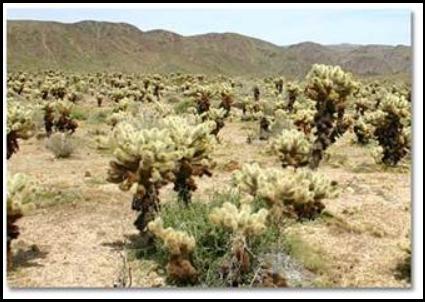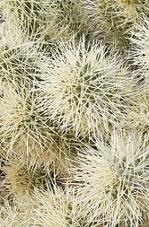|
Cholla Cactus, Curiosity and a Tenderfoot An essay by James A Graves, Jr.
I arrived in Ajo, located in southwestern Arizona, in the fall of 1980. My employer, Cubic Corporation, relocated me from my previous assignment at Eglin AFB Florida. The transfer was semi-involuntary, I desperately needed a place to escape, so the personnel director for field engineers gave me two choices, the US Navy Yuma TACTS Tracking Instrumentation System in Tacna, Arizona, or the USAF Luke ACMI TIS in Ajo.
Tacna, on Interstate 8, 40 miles east of Yuma, had a gas station and a bar. Ajo, 90 miles southwest of Phoenix, was a bit bigger; it had several restaurants, two grocery stores and a small hospital. I picked Ajo - food and emergency medical aid are high on my list of necessities.
Southwestern Arizona is in the northeastern quadrant of the Sonoran Desert, referred to as the “green desert”. I had never been to the Southwest US and knew nothing about the desert. The Merriam-Webster dictionary defines “Tenderfoot” as “a newcomer in a comparatively rough or newly settled region; especially, one not hardened to frontier or outdoor life.”
Concerning the desert, that fit me perfectly. I should have been required to wear a tee shirt with that definition emblazoned on the front, and back, as a warning to Arizona natives and residents. But, despite my tenderfoot status, being the inquisitive person that I am, I was anxious to explore and learn something about the Sonoran Desert, which was, like it or not, my new place of residence.
One of the first places I visited was The Organ Pipe Cactus National Monument, located south of Ajo, not far from the US-Mexico border. It is an interesting place to visit. Organ pipe cactus is very rare in the northern Sonoran Desert, and grows primarily within the 517 square mile park. There’s also a desert museum, with all sorts of natural displays and interactive videos about the desert flora and fauna, and nature trails, with descriptive walking paths through desert flora. And the “flora” includes lots of cactus that is found in the Sonoran Desert.
It was a typical Southwestern desert October day - severe clear and 100+ degrees. So I showed up at Organ Pipe looking like a typical tourist from Florida, wearing shorts, a tank top and flip flops… in other words, “Tenderfoot”.
I educated myself about the desert by viewing all of the displays in the museum first, and then, with my new, in-depth knowledge of the Sonoran Desert, I began wandering through the nature trails, taking in the sights and reading all of the info provided along the way. I learned about mesquite trees and Palo Verde trees (which in Spanish means green stick), ocotillo cactus, barrel cactus, fishhook cactus, prickly pear cactus, and saguaro cactus, and, naturally, I just had to touch the thorns of each type of cactus to see for myself how sharp they really were.
And they are all very sharp indeed. But I knew that. After all, I wasn’t born yesterday. We have prickly pear cactus in Florida. I even squatted down on one while playing hide and seek one night, which was quite a memorable and educational event for me. (I never could get all of those tiny hair-like thorns out of my shorts or under wear and finally had to throw them away)
As I continued to explore the nature trails I came upon a Cholla (choy-ah, ‘choy’ rhymes with boy) Cactus, or Jumping Cactus, as it is often called. So I read the informational plaque, as well as the warning in the pamphlet that I had, which emphasized never to touch a Cholla Cactus, because the jumping part is not just a nickname. It really does seem to jump. At least, that’s what the info claimed.
Cholla cactus is actually clusters of seed pods in the form of green balls with yellow thorns or spines, and resembles a sea urchin. A seed pod attaches itself to an animal that brushes the plant and gets carried away to be dropped elsewhere, or the pod drops from the plant to the ground and is taken by a rabbit, rat or whatever, eaten, and the seeds distributed in that manner.
There’s also another method for the Cholla Cactus to spread its seeds – stupid humans.
I figured that surely it wouldn’t do any harm to very lightly touch the tip of one of the spines. So I did. I didn’t even get a sensation that I had touched anything until the spine-laden ball detached itself from the bush and came with me, causing me to recoil in pain. It felt like a hypodermic needle.
Each spine, which is sharper than any needle in the known universe, has microscopic barbs on the tip that work like the barb on a fish hook. They go in easily, but come out with much reluctance.
The pain in my fingertip was immediate and very unpleasant. And with every movement, the barbs on the spine helped to work its way deeper into my finger. At that point, a tool, like needle nose pliers, is necessary to extract the spines and remove the pod. I didn’t even have a pocket knife. The other option is to carefully sling the pod away from you, like tossing a Frisbee, and hope the centrifugal force will pull the skin-embedded spines out of the seed pod as it is ejected.
I didn’t do that. My brain couldn’t think that far. I was having flashbacks of the time I tried to gently pick up a feral kitten, remembering the pain as it locked onto my hand with claws and teeth like a monster from a science fiction movie. All I could do was utter pitiful sounds of helpless pain until it decided to release me. Unfortunately, the cholla seed pod didn’t have a brain – at least I was under the impression that it didn’t – and consequently, it had no plans to release me.
So, in desperation, I carefully tried to remove the pod with my other hand. Result: instant cholla handcuffs. Followed by much foul language, and more unnecessary movements, which caused more fingers to be speared, inflicting much more pain.
Realizing that I was quickly losing control of my situation, I became even more desperate and tried to use my right foot to free at least one hand. The soft rubber sole of my flip flop was immediately speared, along with several toes, producing much, much more pain. And that prompted even more foul language as I realized that I’m now bound hands and foot, looking like a roped and dogged human-calf in some strange, Twilight Zone, one-man rodeo clown show. All because of one small cholla seed pod. Thankfully, I didn’t have an audience. I was alone in my moronic misery, which was very small consolation.
Faced with no other choice, I used considerable force to very painfully rip the cholla’s attachment from my foot. The seed ball ripped away, leaving multiple spines embedded deep in my toes and shoe. Although my foot was now freed, I was still entrapped by the cactus handcuffs, and thanks to my pitiful attempts to free myself, I’m now attached with even more spines in almost every finger.
The pain has now gone beyond the level that I consider torture. I limped around in circles like a wounded animal until I finally collected my thoughts enough to figure out that the only way I could free myself was to find a limb that I could reach my arms around, which was strong enough to hold the cholla pod so that I could pull both hands away at the same moment.
After an extended search I found a suitable palo verde limb. I positioned the cholla ball, gritted my teeth and snatched my hands apart. I immediately wished that I had a piece of leather to bite down on like in the movies just before the bullet is extracted. And I don’t recommend hugging a palo verde tree – which also has thorns, but my theory worked; the evil cholla seed pod was finally free to sew more cholla bushes. Unfortunately for me it left most if its spines embedded in my fingers, toes and shoe.
I pulled the large spines from my fingers with my teeth, each spine releasing with painful reluctance, and then pulled the large spines from my throbbing toes with throbbing fingers.
I then limped back to my van, used needle-nose pliers to extract as many spines as I could, cancelled my visit to Organ Pipe and returned to my motel room, humiliated and discouraged.
Welcome to the Sonoran Desert, Tenderfoot.
I nursed the painful wounds from the cholla spines for hours. The wounds were sore for several weeks.
And from that brilliant first encounter, I made several, very important rules;
1 - Wear appropriate clothes and shoes when venturing into the desert. 2 – Carry a knife. 3 – Don’t get within 50 feet of a Cholla Cactus bush without needle-nose pliers on your person.
Visit the Sonoran Desert if you get the chance. It’s truly amazing.
©2017 James A Graves, Jr. |

